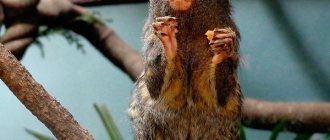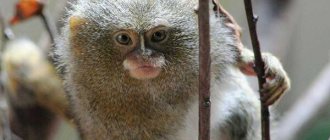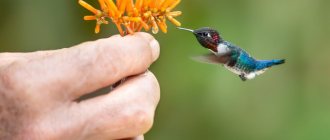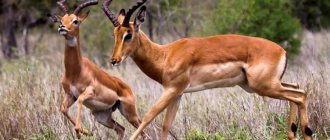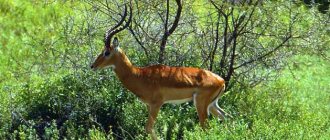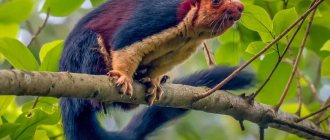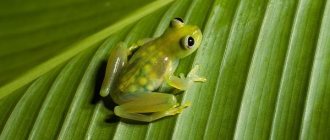The miniature antelope called dik-dik lives exclusively in Africa. It is not the smallest in the world, but some individuals sometimes fit in the palm of an adult. This doll-sized animal with a harmless appearance is endowed with a surprisingly fighting character and can even behave quite brazenly.
Dik-dik prefers to live in rocky and limestone deserts and thorny bush savannas. It is rarely seen in open areas. The animal usually hides in dense thickets of bushes, where it makes for itself the same tiny paths as itself. For this reason, larger animals are not able to get there, and hyenas, leopards and other predators are not afraid of dikdiku.
Lifestyle
These babies live alone, very rarely pairing up. They feed on fruits, berries, and leaves in the undergrowth. They usually have no problems with food. This allows us to consider the population quite stable. According to the latest data, today there are 62,000 animals of this species.
Many local tribes took the initiative - they called not to hunt royal antelopes, since for many peoples the smallest antelope is a symbol of wisdom.
At the same time, there are those who kill these defenseless animals for meat. This is the most serious danger awaiting this little one.
Common species of red-bellied dikdik
Dik-dik was first described by Europeans Buffon and Bruce in the 18th century. The scientific description of the animal was given by de Blancville under the name "Antelope saltiana". Later, scientists continued to study this species and in the 19th and 20th centuries more than ten subspecies were described, today four have been precisely identified:
- Mountain dik-dik (Madoqua saltiana) is distributed in Djibouti, Eritrea, Ethiopia, Sudan and Somalia, the type species that was first described by scientists.
— Advertising —
- Somali dik-dik (Madoqua piacentinii) - common in eastern Somalia. A very rare species, which today is considered vulnerable and endangered.
- Gunther's dikdik (Madoqua guentherii) - found in countries such as Ethiopia, Somalia, Kenya and Uganda.
- Common dik-dik (Madoqua kirkii) is the most common subspecies.
Varieties
There are 4 varieties of these babies. The animals mainly live in limestone and rocky deserts and savannas, where thorny bushes grow in abundance.
Dik-diks mostly hide in dense bushes and are almost impossible to find in open spaces. They build tunnel paths for themselves, through which only they can pass. A larger animal simply will not fit there. They are not afraid of hyenas, leopards or large predators.
Although the dik-dik is not the smallest antelope, its body length is only 45 cm, its height does not exceed 35 cm. They weigh only 2 kg; there are larger species, but their weight does not exceed 5 kg.
This animal is very reminiscent of a funny toy. The charming image is complemented by slender thin legs, a sharp muzzle, on which a small nose-proboscis wrinkles funny.
Antelope dik-dik: where can you see it?
Some zoos around the world keep these African babies. At the Chester Zoo (a city in England), a female recently gave birth to offspring, this is the first case of mini-antelope breeding in captivity. But the mother abandoned the baby and the staff had to nurse him. The size of a newborn is only 25 cm.
There are not many of them in our country:
- In 2016, the Moscow Zoo adopted two females. You can find them in the internal enclosures of the pavilion “Ungulates of Africa”;
- The well-known private park “Sparrows” in the Kaluga region has experience in dik-dik breeding. They were brought here in 2008 in the amount of 6 pieces. These were animals of different species: three were Kerk's dik-diks, and three were the rarest Somali ones. But the whimsical Somalis did not take root in the “Sparrows” and were transferred to the Moscow Zoo for education. However, even there they could not come to terms with captivity and soon died.
In captivity, these babies often die, although in nature they live for about 10 years. Therefore, few nurseries agree to keep them.
Small Madoqua saltiana (dik-diks) are a miracle of nature, difficult to see among the thorns and shrubs of the African shroud, but they are related to the wildebeest or bongo: large, strong animals. But if we already know enough about the life of the latter, then little is known about these crumbs, and yet they are one of a kind.
Therefore, it is necessary to try not only to preserve the population, but also to study it as much as possible in order to pass on this knowledge further. They will help you learn how to breed them in captivity, which is important to be able to do, given the vulnerability of the animal.
Behavior in nature
This small antelope is a territorial animal. Each pair has its own plot of land, which the male fiercely guards. The size of the territory can be up to 20 hectares. Every day its borders are patrolled by a married couple, and sometimes the cubs also go out on such patrol.
When marking their territory, these antelopes make a loud, whistling, high-pitched sound similar to “dik-dik.” This is where the name of the animal comes from.
Battles for territory happen very rarely and do not lead to tragedies. Usually one of the “fighters” either immediately runs away, or slowly, after unsuccessful clashes, retreats into the bushes.
In addition, this whistling sound is an alarm signal when a predator appears nearby. Instantly the small antelopes disappear from sight among the bushes.
Over short distances, the dik-dik accelerates to 42 km/h. This is quite enough to get to the saving bushes.
The animal is most active in the morning, evening and at night, as it does not tolerate heat well. With the onset of the rainy season, when the air temperature drops slightly, they come out of their shelters during the daytime.
Dik-diks are very trusting and curious. This has long been used by local residents who hunted these babies for their skin (gloves are made from it).
Features of reproduction
Dik-dik antelopes are terrible owners; a pair marks the territory in small groups and zealously defends it. When the female is ready for the mating season, strangers try to break into the family’s territory, but the males do not sleep and drive them away.
There are known cases of aggressive behavior of males towards their female friends. If she allows herself to go on a spree on someone else's territory, he drives her home in a rather rude manner.
Pregnancy lasts 6 months, several babies are born, but few survive. Girls and boys develop differently, females reach maturity at 6 months, males at 12. After this, parents kick them out of the house, mothers - girls, dads - boys.
Such rapid maturation is due to the high mortality of animals; having driven some out into the wild, the parents will begin to produce new offspring.
Nutrition
Dik-dik will not eat anything. This animal is selective when it comes to food. Their diet mainly consists of leaves, stems, flowers, seeds and pods of trees and shrubs. They can also nibble grass, but this is not their main food. The necessary moisture is obtained from plants and morning dew. That is why they can survive even in arid areas where there are no bodies of water.
Behavior of the red-bellied dik-dik
Dik-diks live mainly in pairs, sometimes they are observed in small herds.
Each pair has their own territory, which they use for several years. The male marks the boundaries of the territory, leaving small piles of droppings and odorous secretions from the infraorbital gland on them. In this way he marks stones and bushes in the territory. The sizes of territories are varied, sometimes a diameter of 50 to 100 m is sufficient, sometimes a site occupies an area of up to 500 m in diameter. Dik-diks rest in secluded areas in the border zones of their territories. Animals usually go out to graze in the morning or at dusk; during the day they can also be seen quite often; on moonlit nights, these miniature antelopes graze until dawn. Dik-dik is a very trusting animal, and very often suffers from it. Residents of Africa can kill him simply by throwing a stick.
physical characteristics
Female dik-diks are slightly larger than males. Males have small horns (about 7.6 centimeters or 3 inches), sloping backwards and with longitudinal grooves. The hair on the top of the head forms a straight tuft, which sometimes partially hides the short, ribbed horns of the male. The upper body is grey-brown, while the lower body, including the legs, belly, crest and flanks, is yellowish-brown. A bare black spot at the inner corner of each eye contains the preorbital gland, which produces a dark, sticky secretion. Dix-dix insert stems and branches of grass into the gland to mark their territory.
Apparently, to prevent overheating, dik-diks have elongated snouts with muscular muscles through which blood is pumped. The air flow and subsequent evaporation cools this blood before it returns to the body. However, such breathing is realized only in extreme conditions; dik-dix can tolerate air temperatures up to 40 °C (104 °F). [3]
Kudu
The world's third largest antelope species, the kudu, belongs to the genus Tragelaphus. They can be divided into two species, the lesser kudu and the greater kudu. Greater kudu can be found in various parts of the world, while lesser kudu are essentially limited to East Africa. Besides size, the best way to differentiate the two species is to look at the number of white stripes on the sides of their bodies. The greater kudu has only 6 to 7 stripes, while the lesser kudu has about 14 stripes. Kudu have very recognizable long and spiral horns and are herbivores.
What does the pygmy antelope eat?
Photo: Dwarf antelope in nature
This mammal, like other artiodactyls, is a herbivore. It prefers fresh grass, foliage and shoots of bushes, flowers. The miniature antelope will also include various juicy tropical fruits in its diet: fruits and berries, as well as mushrooms.
Due to the abundance of moisture in the tropical forests of southern West Africa, all plants contain a lot of juice, eating them, the royal antelope no longer feels thirsty, and therefore does not need sources of water and does not look for watering holes.
The cheek muscles of the dwarf antelope are not as highly developed as those of other, even the most closely related subspecies, for example, Bates's antelope, although this little one is only slightly larger. This structural feature, as well as a small mouth, does not allow even-toed ungulates to eat woody shoots. But nature took care of these animals, rewarding them with a longer and narrower muzzle and wide lips, which can be used to grab young foliage in dense thickets.
In search of better places with new food sources, these bovids can move to new territories, but since in the tropics the growth processes of plants proceed very quickly, the little ones do not have to travel long distances, only small movements in the same territory are enough.
The threat of extinction of these antelopes
The number of artiodactyls has been rapidly declining recently, and it’s not about predators, but about people uncontrollably catching them.
Little ones are trusting and curious - they reach out to people without any fear. The Africans, realizing this, actively take advantage of their affection and kill them by throwing stones at them.
This fact could be understood if the killing of mammals is necessary for human sustenance. But it turns out they are destroyed for the sake of the skin, which is ideal for making gloves, bags or souvenir keychains. In this case, a pair of gloves requires killing two animals.
In the 60s, hunting took on an industrial scale; hundreds of thousands of precious skins were exported from Somalia every year. Thus, the mountain species was included in the International Red Book and is today under protection.
Appearance and features
Photo: What a dwarf antelope looks like
This amazingly small bovid-horned artiodactyl is only a quarter of a meter tall at the withers, and with its head it is no higher than half a meter. The weight of a dwarf antelope is no more than three kilograms, usually about 2 - 2.5. The animal's legs are slender, thin, graceful. Only the heads of males are decorated with black cone-shaped, smooth horns; their length is 2–2.5 cm. They are slightly curved back. At the base of the horns there are ridge-like thickenings.
Interesting fact: The forelegs of the royal antelope are half as long as the hind legs, so the outline of the silhouette gives the impression that they are constantly inclined to the ground, making the animal comparable to a hare, both in body shape and size.
The coat is soft, brown with a red or golden tint. In the center of the head and back the shade of the coat is slightly darker than the main one. Starting from the chin, down the throat and belly, along the inside of the legs there is white, but in the middle of the chest it is divided by a brown “collar”, forming a white “shirt front” on top of the throat. Also white is the tuft of hair at the end of the tail. The tail is thin, up to eight centimeters long.
Interesting fact: In the dwarf antelope, females are larger than males, and their cubs can easily fit in the palm of a person.
The baby antelope's eyes are round, large, and dark brown in color. The ears are translucent and small. The rhinarium of the nose is wide, without hair, grayish-pink.
Video: Lioness and baby antelope
Love conquered the hunting instinct
You might be interested in reading:
- NEW YEAR 2014 January 3, 2014 New Year 2014 is sweeping across the planet. We prepared in advance, dressed up...
- SNOW SNOWBALL January 8, 2014 This winter is unusual, we are not spoiled with snow. They even posted it on social networks...
- POLE DRESSING January 22, 2014 What associations do you have when you hear the word “dressing”? Probably a hospital...
- Are exotic animals needed in December 2, 2013 Currently, one can observe a real boom, a new surge in fashion...
- SMALL DOGS. PROS AND... February 2, 2014 Let's say that you have firmly decided to get a four-legged friend, but not...
Social structure and reproduction
Photo: Baby pygmy antelope
Baby antelopes are monogamous, but there are also cases of polygamy. To mark territory, pygmy bovids have preorbital glands. They are not very developed, but the animals mark their habitats with their scent, rubbing against plant trunks, and also marking the territory with feces. Animals do not gather in herds and less often live in pairs, although females prefer an independent lifestyle.
Since the animal is very shy and leads a secretive lifestyle, the rutting period and gestation periods are not known to zoologists, but it is assumed that gestation lasts about six months. These mammals have offspring once a year. Females give birth in late autumn and early African winter. Here, in the southwest of equatorial Africa, the change of seasons is almost invisible, and can only be marked by a calendar; these are the months of November-December.
A litter always consists of one individual. The weight of newborn babies is about 300-400 grams, they are very fragile, less often, older and larger females give birth to babies weighing 500-800 grams. The delicate fur of babies is identical to the color of adults. For about two months, newborns feed on mother's milk, gradually switching to pasture.
Six months after birth, the antelope reaches sexual maturity. Pygmy antelopes can be seen grazing in small family groups, along with young, growing children who have not yet mated. On average, life expectancy in the wild is estimated at 5-6 years; in captivity, animals live 2-3 years longer.
Dik-Diki - big-eyed little ones
The famous traveler, biologist, artist, photographer Vasily Klimov visited the National Park in Kenya, where he saw a real miracle of nature and received such impressions from this meeting that he simply could not remain silent. That’s why I wrote a detailed artistic and documentary story about all the events that took place, generously flavoring it with scientific information. The reader will vividly feel the delight experienced by the author at the sight of miniature bush antelopes, similar to soft toys from a children's corner. Dik-dik (this is a small antelope) can fit in the palm of your hand with all four of its hooves!
The author enthusiastically talks about the species of animals, their habitats, characteristic behavioral features, and diet. It is interesting that the kids have a fully developed male character. Pointing sharp horns at the enemy, he attacks anyone, no matter how large in size. This wild animal has an ancient history: fossilized remains of dik-dik have been found throughout almost all of Africa and are at least five million years old. Dik-dik antelopes know how to survive! They also colonize the rocky deserts of Namibia, live in the prickly savannas of Tanzania, and even take root in mountainous areas. They run fast and jump wonderfully, very nimble animals.
Small stature is not a hindrance to fighting qualities. Dik-dik's character is irreconcilable. They live in communities where it is customary to warn about danger. You can imagine how scary it is for these kids to live in Africa, overcrowded with large predators! If not for courage, we would not have survived. The author humorously tells how a kid, shorter than a car wheel, walked around the uninvited guests, expressing displeasure, and finally pierced the tread with sharp horns. He made it clear that people are not the masters here, and they have nothing to do in the antelope territory.
2659
Early morning in Nakuru National Park, Kenya. The entire territory of the lodge (something between a recreation center and a hotel), consisting of clearings surrounded by huge trees, ponds, streams quietly murmuring towards the lake, is immersed in sleep and fog.
There is a tropical forest around the wall, and from there the faint voices of birds can be heard. And in the distance, in the valley, Lake Nakuru brightens with flocks of pink flamingos that quietly cackle at dawn. Nature is still sleeping, and everything around is dozing, only the fog spreads in wisps across the clearings...
Suddenly two small shadows appear in the clearing. They slowly and hesitantly stomp around, examine the bushes and gradually move forward. It is clear that here they feel like guests, not hosts. Who are they?
I try to get closer to them to get a better look, but they immediately run away as soon as they notice my movement. But not headlong, as frightened antelopes do, but on ledges, peeking out from under every bush they went behind.
I conclude that they are more curious than fearful. After some time we got used to each other, and I managed to get closer. This is a wonderful little creature with matchstick legs. An elongated muzzle with a proboscis, a hump on the nose and a tuft of hair sticking out between the ears give it a comic expression. It has huge, moist eyes, from which, like a tear, the shell of the gland “flows”, with which this creature marks its territory. Yes, this is a pair of dik-diks - small bush antelopes! They look more like a toy than an animal, because they are smaller in size... than a hare. Yes, yes, such a creature can fit all four hooves in the palm of my hand!
Despite this, the dik-dik is very collected, armed with sharp horns and pikes and can easily attack an enemy several times its size. Often meeting these babies in the bush, we gave them all the shortened name “dick”.
Observant African aborigines have a bunch of myths and tales about almost every type of animal. One legend-fairy tale is dedicated to dik-diks. It turns out that once upon a time all dik-diks lived in herds and grazed together on the plains. And then one day, while crossing, one of the animals fell behind, ended up in a large elephant pile, and died there. Great was the grief of his relatives and friends when they gathered to honor his memory. At this meeting, they decided: from now on, all dik-diks perform their toilets in only one place, so that there is such a huge pile that one day the elephant himself will fall into it and die there! Such was the revenge of the small antelopes, who to this day return to one place in their areas.
Fossilized remains of dik-diks found in Africa are 4–5 million years old. Even then they lived on the plateaus of the Horn of Africa (Somali Peninsula), and since then their evolution has taken place here and on the plateaus of East Africa, right up to Namibia. Even today, on the edge of the Ethiopian plateau and on the coasts of Somalia, in the evergreen thickets of bushes, live the heirs of these ancient forms, the most conservative of all the antelopes of this group (dik-dik Soli). The most advanced forms, resistant to high temperatures, live in the driest deserts and semi-deserts. More conservative forms counteract high temperatures by transitioning to a crepuscular and nocturnal lifestyle, while more advanced (proboscis) forms, with the greatest adaptability to these temperatures, are more diurnal (Günther and Kirk's dik-diks).
In taxonomy, these antelopes are divided into two independent genera - true dik-diks (Madoqua) and proboscis (Rhynchotragus) - or all are assigned to the genus Madoqua. The most famous are the red-bellied dik-dik (Madoqua phillipsi) and the small dik-dik (M. swaynei), which are found only on the Somali peninsula, the mountain dik-dik (M. saltiana) - in Eritrea, and Guenther's dik-dik (M. guentheri) – in Northern Kenya and Ethiopia. More widespread is the common dik-dik (M. kirki), the range of which is divided into two isolated parts: one includes Kenya, Tanzania and Northern Uganda (Karamoja region), the other - Angola and South-West Africa.
They are 30–35 cm high, with thin legs and a pointed muzzle ending in a movable proboscis-nozzle. In this respect, the diki are similar to our saigas. This is a very slender, even graceful creature, painted in gray, speckled tones with yellowish shades of ocher. The muzzle, crest between the horns and legs are colored yellowish-brown, the belly is light. Around the huge and moist eyes there are beautiful white “glasses”, below there are black shell holes, these are the brood ducts of the preorbital gland. The males have two sharp horns about 10 cm long protruding from the top. Here in Kenya, Kirk's dik-diks (Madoqua kirki), the most common of these antelopes, are found. The Aborigines call them "digidigi". There are four subspecies of Kirk's dik-diks in Africa. The smallest kirki - livery, live along the entire coast of Somalia, Kenya and deep into the continent - to Lake Victoria and Uganda. They have 47 chromosomes. A somewhat larger form of cavendishi, they live in the highlands of Uganda. They have 46 chromosomes. The thomasi form lives in the bush of Central and Northern Tanzania, and the damarensis form lives in the Namibian desert. At one time their range was apparently united, but over time it became fragmented.
So, in hot Namibia they live in rocky and limestone deserts with sparse vegetation. In the thorny bush savannas of Tanzania (bush) they live in thickets of Grewia, Baphia and Pseudopropsis. This is their typical habitat. In the mountainous regions of Kenya, the most common shrub is Oleau, thickets of Aspilaia, Tinnaea, Turraea and Psiadia, with Sansevieria and aloe. Thus, these creatures manage to survive in a variety of biotopes, sometimes far from each other. This adaptability is due to their special qualities. The flexible proboscis of antelopes is filled inside with numerous respiratory passages, moistened with mucus and enriched with blood vessels. They cool the incoming hot air, increasing the normal breathing rate - from one to eight breaths per second. Cooled blood returns to the heart through the sinuses, where it mixes with hot blood going to the brain. Such selective cooling allows the antelope to maintain brain functions within normal limits, regardless of any increase in overall body temperature. Another adaptation of dik-diks to desert heat is the transition to a nocturnal lifestyle, especially during the full phases of the moon.
Another adaptation of babies is their amazing “nimbleness” when moving. Their movement speeds were recorded reaching 42 km/h. They cannot run for a long time, but in short periods they give their best.
Dik-diks have a very original family structure. They, like us, are monogamous; each male has only one spouse, to whom he is faithful for many years: up to four or five years. But I had to meet harems when the male took 2-3 females and even small groups with him. All this time they occupy the same bush territory, which they carefully guard from the invasions of their fellow tribesmen. This is their feeding territory, which is very important in dry bush or desert conditions, with a clear shortage of food. If one of the spouses dies, the other remains on its territory and forms a new couple here. The size of these territories ranges from 0.3 to 35 hectares, with an average of 5–20 hectares.
The entire area is pierced inside by many tunnel-paths made by wild people in the thickets of thorny bushes.
When I tried to crawl along one of them, I got stuck immediately. Only these little ones can fit in them.
The boundaries of the site are actively patrolled by a male and a female together, and sometimes by their children. At the same time, the male marks his path (boundaries and paths inside) with secretions of the preorbital glands, urine and feces. It touches twigs and leaves with its preorbital gland, transferring its scent to them. He also marks his wife and children with his scent, who should smell only of him! After all, the smell for him is a standard, a sign of distinction for his family and him personally!
In addition, the male adds his excrement to any new, strong-smelling intrusion into his territory, be it the tracks of a competitor or any other animal. It is interesting that even the huge elephant heaps that appear on his territory are marked by the male, as if trying to intimidate even the elephant. The local natives have another legend that the dik-dik accumulates its own balls on the elephant heaps in the hope that it will (finally) become confused and stop walking through its area.
Family territories are a kind of mosaic of bushes, clumps of trees, clearings, ravines, paths, etc. Somewhere here is the “core zone” - the family’s favorite lands, where they hide from enemies and relax. These are the clearings and areas where they graze, as well as 6-13 “control points” or “stations” that are visited especially often, as can be seen from the fresh piles of excrement. Those of them that are located on the boundaries of the plots are visited and marked with particular enthusiasm by two or even three males at once - the owners of adjacent real estate. When they meet, they both whistle hoarsely, show each other their own “coolness” and sharp horns, but things usually don’t come to conflict. If a neighbor or a completely unknown tribesman invades someone else's territory, then the owner, after a series of threatening demonstrations, proceeds to hostilities and then turf and wool fly in different directions from the fighters. Despite their small size, these are very fighting and irreconcilable creatures that can insist on their own!
When a hyena, an aboriginal dog or a leopard approaches, the male gives specific signals that resemble a loud whistle. As soon as it is heard, the whole family hides or hides in the thicket of the bush and the catacombs of their site. By whistling, the dik also distracts the predator and transmits an alarm signal. Fleeing from the enemy, the little ones make huge leaps and in the blink of an eye they all disappear among tree trunks, continuous thickets of bushes and stones. As soon as the danger passes by, the family invariably unites with the indispensable mutual ritual of the husband sniffing and marking his betrothed and children with his own scent.
For me, the very existence of these little ones in the wild, ruthless nature of Africa has always been an insoluble mystery. How do they, so small and defenseless, survive surrounded by a host of all these hyenas and leopards?
This became clear to me only in the Serengeti (Northern Tanzania). There are two main types of biotopes here - the endless open expanses of the steppe and the impenetrable wall of thorny bushes along the Grumeti and Orangi rivers. So, in the open steppe there is not a single dik-dik, and they all lurk among the thickets of bushes. So much so that they disappear literally before our eyes: here they were, now they are no longer there! In the hole-tunnels that they make in these thickets, only dik-diks can fit and squeeze through, but not such a large animal as a leopard or a hyena! As long as there are thorny bushes in Africa, dik-dik is invincible!
During the dry season and hot weather, dik-diks feed at night, in the morning and at dusk. During the wet season, when it is cooler and the savannah is in bloom, they become more active, so sightings of them are common during the day. In the conditions of the eternal African summer, antelopes will always find food for themselves. These are stems and leaves of steppe and meadow grasses, shoots and leaves of shrubs.
Once or even twice a year, after a six-month pregnancy, the female gives birth to one cub. This usually happens at the end of the rainy season. The newborn hides in the thicket, and for a long time the mother visits him only to lick and feed him. Then the baby joins the family, and adults raise and teach him about life. The children remain on their parents' property until puberty (6–9 months). By the age of one year, the adult male expels his sons, and the mother expels her daughters. Having left the territory of their parents, the young try to settle in the spaces between the already occupied areas. Typically, such an exile does not go far and tries to “stake out” his own plot on neutral ground between the parent plot and the neighboring couple. Individuals that are able to develop their own territory acquire a marriage partner and remain here until the end of their lives.
I have always been interested in understanding the character of this or that living creature, but especially the dik-diks, which, as it turned out, are completely contradictory creatures. There are especially many of them in Samburu, in northern Kenya. This is the beginning of the great Somali deserts, and here stands a continuous bush of thorny bushes on red soils. Dicks are found here all the time, at every step, they are everywhere - in the grass, under the bushes, out on the red road and walking back and forth.
Apparently, they divided the entire region among themselves millions of years ago, and since then this entire system has only been improved. Each family “stakes out” their own plot of land, maintains it in constant skirmishes and conflicts with neighbors, and here we are constantly invading someone’s land with our car, which causes them justifiable indignation. These graceful kids live their own separate and unreal lives. Some lie serenely under the bushes and rest, others parade along the road, others look after the females, others feed, etc.
It would seem that the smallest antelope of the savannah, surrounded on all sides by dangerous bloodthirsty predators, should be afraid of everything in the world, even its own shadow. But no. Dik-dik behaves not just independently, but independently and in some ways even brazenly! Being smaller than our wheel, he walks back and forth in front of the car, looking for something, scratching himself, picking leaves, sniffing flowers and with his whole appearance makes it clear that he had us in mind and we are superfluous here! There is zero attention to us, to the car, although he sees people well and hears our conversations in which we discuss him. There is nothing in common with their behavior at the lodge on Lake Nakuru. There they came to visit and behaved modestly, but here they are on their own territory, which they conquered from competitors, and some impudent people have locked themselves in on it! Disorder! Here we meet three wild people at once. The male stands and looks at us, and two females lie under the bushes. Under his protection they feel completely calm. Further - two other dicks are passionate about each other. You see, they have love - the male sniffs his girlfriend and cares for her. There is zero attention to us, the huge iron box of the car!
Here again there are thorny intertwined thickets of bushes on the river bank. Guinea fowl, guinea fowl and tiny dik-diks come out into the clearings, carefully and clearly rearranging their pencil-thin legs. They look at us with their huge wet eyes and shake their sharp horns. We stand, watch, wait for what will happen next. Despite their miniature size, the kids are quite independent and fearlessly walk around two steps away from the jeep, trying to touch our wheel or one of us with their horns. One of the males poked the tire tread with his “matches”, as if showing the degree of contempt for us. Having decided not to irritate the “serious guys”, we leave them and move on.
With the constant increase in the aboriginal population and its livestock, constant military conflicts, the presence of uncontrollable gangs of black people with firearms, etc. The number of all antelopes, and dik-diks in particular, is steadily declining. They are very curious and quite trusting of humans. This property costs them dearly: Africans easily kill them with a simple throw of a stick, shoot at them with any weapon and place nooses on their paths. The skin of dik-diks is used mainly for gloves, and since a pair of gloves requires the skins of two animals, it is easy to imagine the rate of their extermination. In 1960, more than 400 thousand dik-dik skins were exported from Somalia! They are especially sensitive to hunting pressure, competition with agriculture and livestock. Some species are able to cope with these factors better than others, others worse. Although many of the African antelope species occur in protected areas, management and control of poaching is either minimal or nonexistent in many reserves, especially in the western and northeastern regions of the continent.
Famous traveler, biologist, artist, photographer, Vasily Klimov, September 4, 2008
Tags: dik-dik dik-dik antelope
← Wandering Nest↑ Notes of a NaturalistAdoptives →
Origin of the species and description
Photo: Pygmy antelope
The first word from the binomial name Neotragus consists of two parts, which can be translated as “new goat,” the specific name also indicates the insignificant size of the mammal and is translated as “small fist.” This artiodactyl has other names; local tribes gave it the name royal antelope. This was first reported by the Bosman trader of the West India Company (in Old English the words stag and king are homonyms). Also, the so-called Antelope regia also has a name - Capra pygmaea, in German the baby is called Kleinstböckchen.
Video: Pygmy antelope
German zoologist Simon Pallas described two species of dwarf antelope Tragulus pygmaeus and Antelope pygmaea, but upon closer study and genetic analysis it turned out that both of them belong to N. pygmaeus. The subfamily of small antelopes is divided into eight genera and fourteen species, but this division is very arbitrary, since the appearance and lifestyle of some of them are very similar.
The genus of dwarf antelopes has several species with a common origin, these are:
- dorcatragus (beira);
- ourebia (orib);
- madoqua (dikdik);
- oreotragus (klipspringer);
- stenboki.
All these animals are characterized by small stature, a secretive lifestyle, and are found in different regions of Africa. Also, the common ancestors of the dwarf antelope were with not only klipspringer and duiker, but also representatives of the subfamily Cephalophinae.
This even-toed ungulate has fewer family ties with other babies, such as sunyi (N. moschatus) and Bates antelope (N. batesi), which live in other regions of the African continent. They are similar to their Asian counterparts - mouse deer tragulas. The pygmy antelope has a longer muzzle than the Bates's antelope and wider lips, although the mouth is smaller, and is adapted for eating foliage.
Interesting facts about antelopes
The myth of the unicorn was created by oryxes, which have snow-white skin and straight, long stiletto horns. If you look at a photo of an antelope standing sideways, you get the impression that it only has one horn.
A calmly grazing wildebeest can, for no apparent reason, begin “shadow boxing” - jumping on the spot, hitting an invisible enemy with its horns and fighting back with its hind legs. It ends as suddenly as it began, and the wildebeest continues to calmly nibble the grass. No one can yet explain why they do this.
The image of antelopes was found in medieval Europe on the coats of arms of some cities and even kingdoms. In English heraldry, for example, the antelope had the head of a tiger, the tusks, horns and tail of a lion. Currently, antelopes (in their usual form) adorn the coats of arms of Uganda and Zimbabwe.
Natural enemies of the red-bellied dikdik
Since the dik-dik is a very small animal, it is an easy prey for most predators. In dangerous situations, he remains motionless, the male turns his head and watches what is happening, and the females freeze and stand quietly until the danger passes. If the threat is significant, then the animal runs away, jumping from side to side in search of shelter, in which it will then wait until the situation becomes calm.
Gerenuk
The only species of the genus Litocranius and members of the family Bovidae, gerenuks, are also known as the Gazzele giraffe for their long giraffe-like necks. Commonly found in the Horn of Africa and dry scrubland areas of East Africa, gerenuks are a slender hybrid between an impala and a giraffe. They are diurnal animals that are active mainly during the day and most of their day is spent searching for food. Gerenuks generally do not fight or travel very much, mainly to conserve energy for foraging.
